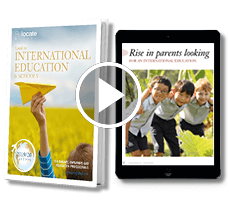US public school vs. private school education for the expat child
What is better for expat children in the US - going to an independent school or an American public school? We look at the US education system and offer some useful pointers to relocating parents to help them make the right choice for their child.

How to choose the right school and education is the top priority for relocating parents
The child’s education is generally one of the employee’s top priorities when considering an international assignment to the States; ultimately it can be the tipping point in an assignment’s success or failure if the child’s school placement and educational environment is not meeting the employee’s expectations. It impacts the entire family and could ultimately trigger an early repatriation.Early repatriation means a loss of investment in the assignment and the potential loss of the employee from the company. The natural inclination has been that the child will receive a better education in a private school than a public school. But, is that really the case? To help protect the assignment investment, optimizing the educational choices in the US should include all options; public school, charter school and private school.How does the US public school system work?
Understanding the US public school system and structure allows the employee to compare a public school, as well as a private school, in the US destination to their child’s school in the home country. Having the child in the appropriate grade and learning segment within the grade provides the child with the opportunity to not just assimilate within a reasonable time but also to thrive over time. So, understanding school levels and segmentations is critical.Public school education in the US is established by each state government and run through its own department of education. The structural segments of education are generally kindergarten through to grade 12. These segments are classified as kindergarten, elementary (or primary school), middle school (or junior high school) and high school, with elementary/primary school generally including grades 1 – 5, middle school/junior high grades 6, 7 and 8 and high school grades 9 – 12, though this segmentation may vary slightly in any given location. Grade 9 is known as the Freshman Year, grade 10 the Sophomore Year, grade 11 the Junior Year and grade 12 the Senior Year.Most US schools follow what is known as the common core curriculum, which was established in 2010 with the Common Core State Standards Initiative. The purpose of the common core is to have a set of standards that measure what children should know in mathematics and English language arts by the conclusion of each school year. It should be noted that the majority number of states adopted the common core curriculum for their public schools, although not all.Public school admission in the US is generally determined by where you live and regardless of whether you rent or own a home. In most states, the child must be ‘domiciled’ within a school district in order to attend the public school there. So, when an employee is coming to the US for a home-finding trip and is considering public school education for the child, it can be a bit of a juggling act to concurrently look for a residence and a school(s). If the employee finds a public school that meets their criteria for the child or children in the family, they will generally need to find a home within that school district.What are charter schools in the US?
In addition to public and private school is the charter school. Charter schools are public schools that operate independently from the mandates of the local school system in which they are located but receive government funding. Parents can choose for their child to attend a charter school regardless of the school zone or district in which they live. The school is established based on a charter or contract granting it greater independence in exchange for greater accountability for student performance and achievement, standards and practices, goals and assessment methodology. By the very nature of this agreement, charter schools generally provide a high quality of education with innovative programs and study opportunities.Education in America: understanding general metrics and figures
When considering a US public school for a foreign national child, it is important for the employee to understand the general metrics used to measure the educational performance of each school. Some critical metrics most often used for evaluation for Pre-K through 12 schools are standardized test scores in math and reading, percentage of children enrolled in kindergarten and the high school graduation rate, with a subcategory of pre-school enrollment as part of the overall picture.These metrics reflect how public schools are preparing their students to graduate high school and for college readiness. The results determine the school’s national ranking. School ranking studies are conducted by different organizations and news outlets such as US News & World Report who announce their findings on an annual basis. Ranking results are often utilized, by both public and private schools, to promote their ranked status with national colleges and universities in the hopes of boosting their graduates’ admission rates.Corporate employees on international assignment in the US have many choices to make when bringing school age children to the US. It is fair to say that regardless of which choice they make as to the type of school to have their child attend, the education the child receives will be equally good, though perhaps different in the pedagogy. For good measure, a curriculum comparison should be conducted to ensure the employee is comparing ‘apples-to-apples’. That curriculum comparison should be a side-by-side comparison of all the schools in consideration whether they are public, charter or private. In so doing, the employee can analyze data per each school that should lead to a clear decision.So, on closer examination, what exactly can help the employee determine the best-fit school for their child? What key metrics and data should be included in the comparison and analyzed to ascertain the quality of a school whose performance and attributes stand above the rest and will allow the child to flourish academically and socially? Let’s take a closer look at the best model for conducting this comparison.How can you compare American schools using all the data?
In specific terms, a curriculum comparison compares just the elements of the curriculum of each school. However, a more extensive model that provides data, not just on curriculum but also on the school itself, will prove far more valuable in order to reach a conclusion and select the right school. While there are potentially hundreds of data points to evaluate, the most common and most telling about a school include: a core curriculum summary, whether the school meets national and state content standards, the student/teacher ratio, as well as number of teacher’s aides per classroom, national test score averages, the school culture and teaching philosophy, core subjects, foreign languages taught at what grade levels, advanced classes taught and at what grade levels, inclusion of music and the arts, remedial subject support and required credentials for teachers. These data points are the very minimum to explore when evaluating the quality of potential schools for the child.If done correctly, there is a great deal of time and effort that goes into an effective and useful comparison of this nature. Further, there needs to be an understanding of exactly what the data represents. This model can be used to compare any number and any type of schools. Having the side-by-side comparison generally provides a clear vision of the top two or three schools for consideration. At this point, a visit to each of the schools with a specific set of questions for the administrator will then leave no doubt which school is the ‘best-fit’.Summary
While the school selection and placement process in the US is not necessarily an easy one, it is worth the time and effort to reach the point of complete satisfaction in knowing that the appropriate due diligence was conducted and resulted in the right school for the child.The employee’s child is their number one priority when embarking on an international assignment. The success or failure of that assignment may rest on their child’s educational assimilation in the US. In fact, it can be the ultimate tipping point. As such, it is always recommended to engage an expert to navigate the employee through the rigours of the school placement process. An education consultant is an academic specialist and expert in the schools of a given location. This consultant will provide the employee with the knowledge and information needed to make a smart choice for their child while removing the guesswork, anxiety and internet-surfing from the equation.For further information contact: Gail Rabasca, Executive Vice President Global Solutions, Chamness WorldWide, Chamness Education ConsultingEmail: gail@chamnessrelo.comThis article is from Relocate Global's Guide to International Education & Schools 2019/20 which is packed with expert tips and information for those relocating and the professionals supporting them. For volume options, co-branded editions, digital or online licence agreements and advertising opportunities, contact Fiona Murchie at +44 (0)1892 891334 or email fiona@relocatemagazine.comNow available as an ebook on Amazon! Simply download from Amazon onto your Kindle, mobile phone or tablet to read wherever you are!
Subscribe to Relocate Extra, our monthly newsletter, to get all the latest international assignments and global mobility news.Relocate’s new Global Mobility Toolkit provides free information, practical advice and support for HR, global mobility managers and global teams operating overseas.
 Access hundreds of global services and suppliers in our Online Directory
Access hundreds of global services and suppliers in our Online Directory For more education and school-related news, visit our Education and Schools pages.© 2019. This revised article first appeared in the 2019/20 edition of the Guide to International Education & Schools published by Relocate Global, Spray Hill, Hastings Road, Lamberhurst, Kent TN3 8JB. All rights reserved. This publication (or any part thereof) may not be reproduced in any form without the prior written permission of Relocate Global. Relocate Global accepts no liability for the accuracy of the contents or any opinions expressed herein.
For more education and school-related news, visit our Education and Schools pages.© 2019. This revised article first appeared in the 2019/20 edition of the Guide to International Education & Schools published by Relocate Global, Spray Hill, Hastings Road, Lamberhurst, Kent TN3 8JB. All rights reserved. This publication (or any part thereof) may not be reproduced in any form without the prior written permission of Relocate Global. Relocate Global accepts no liability for the accuracy of the contents or any opinions expressed herein.©2025 Re:locate magazine, published by Profile Locations, Spray Hill, Hastings Road, Lamberhurst, Kent TN3 8JB. All rights reserved. This publication (or any part thereof) may not be reproduced in any form without the prior written permission of Profile Locations. Profile Locations accepts no liability for the accuracy of the contents or any opinions expressed herein.








































